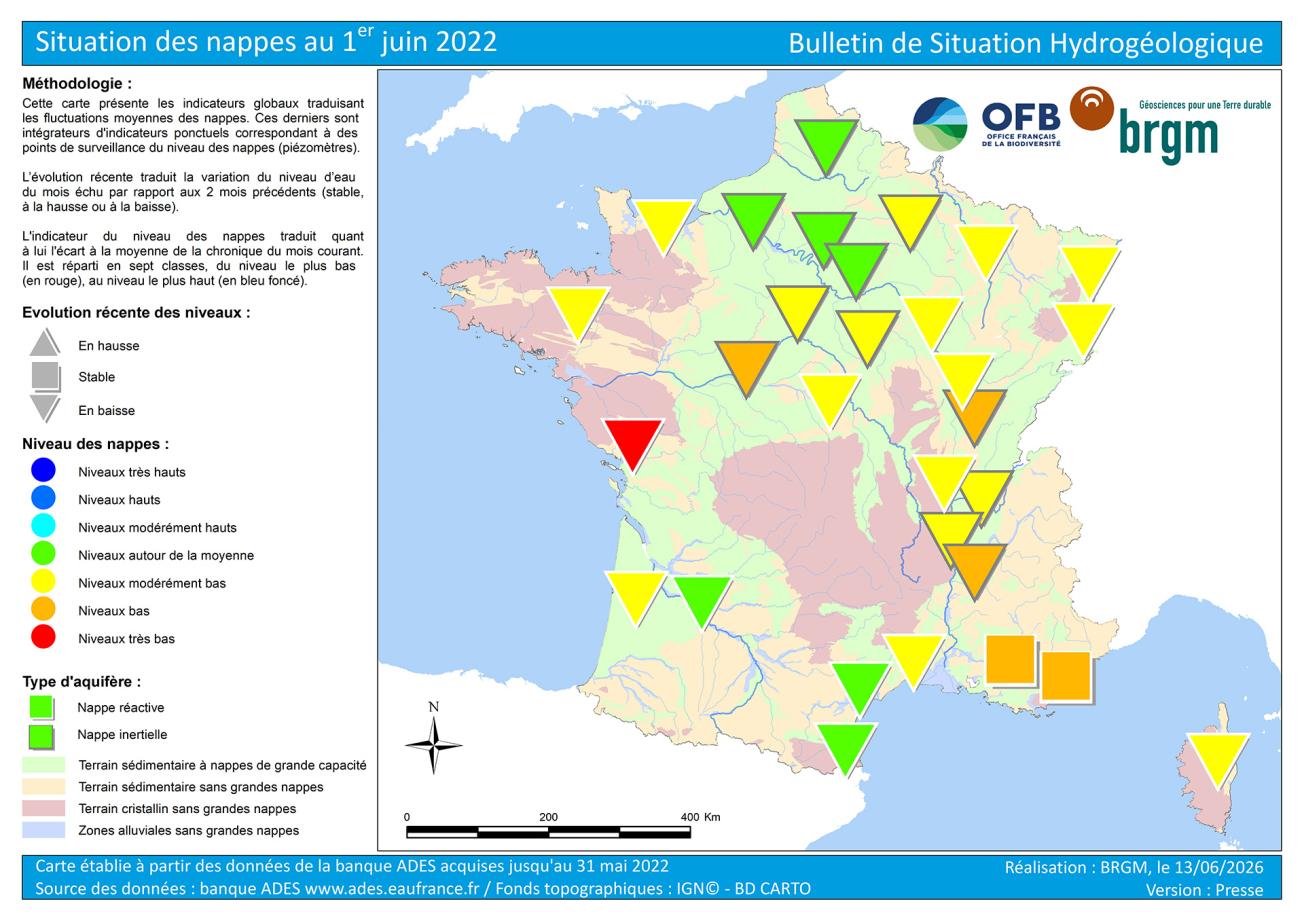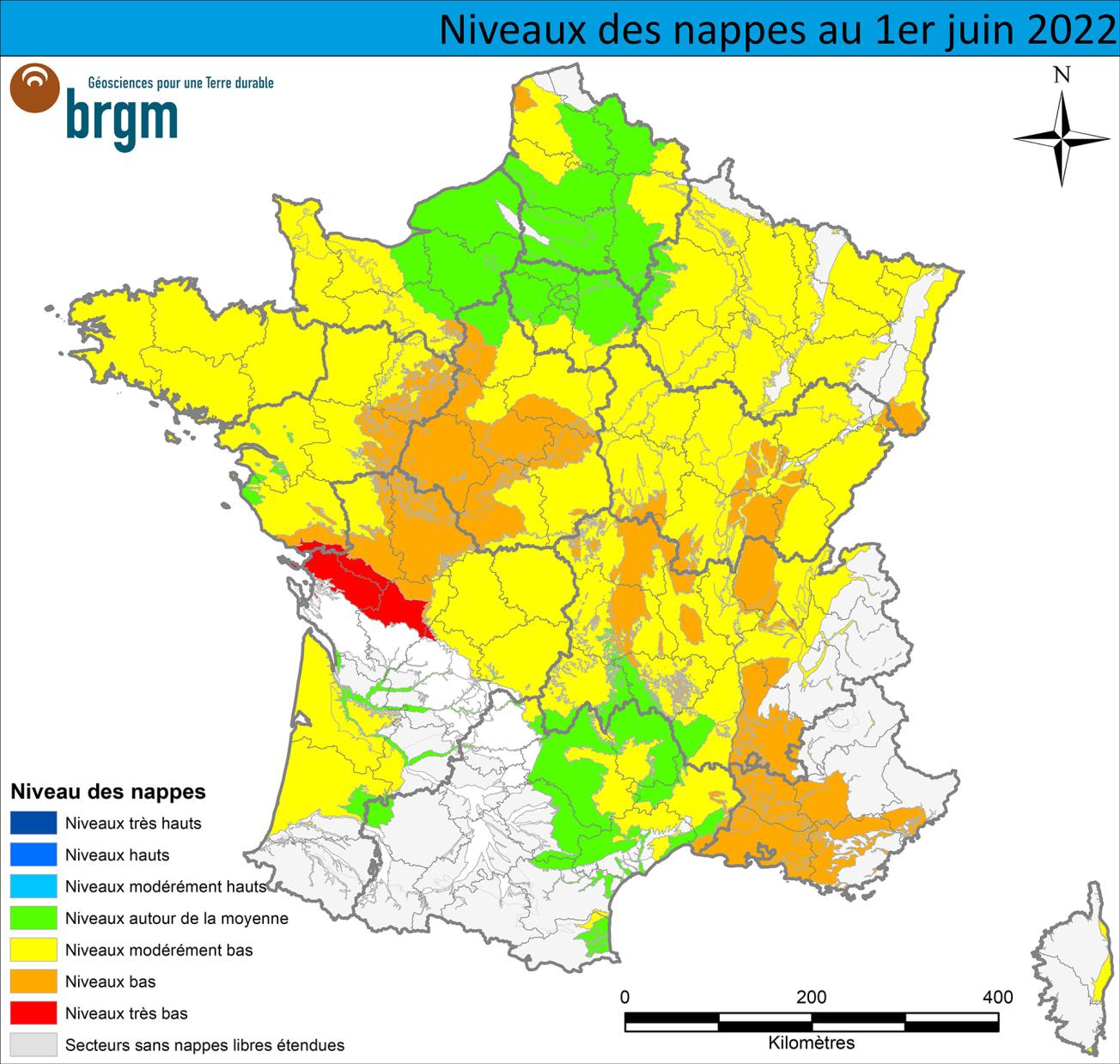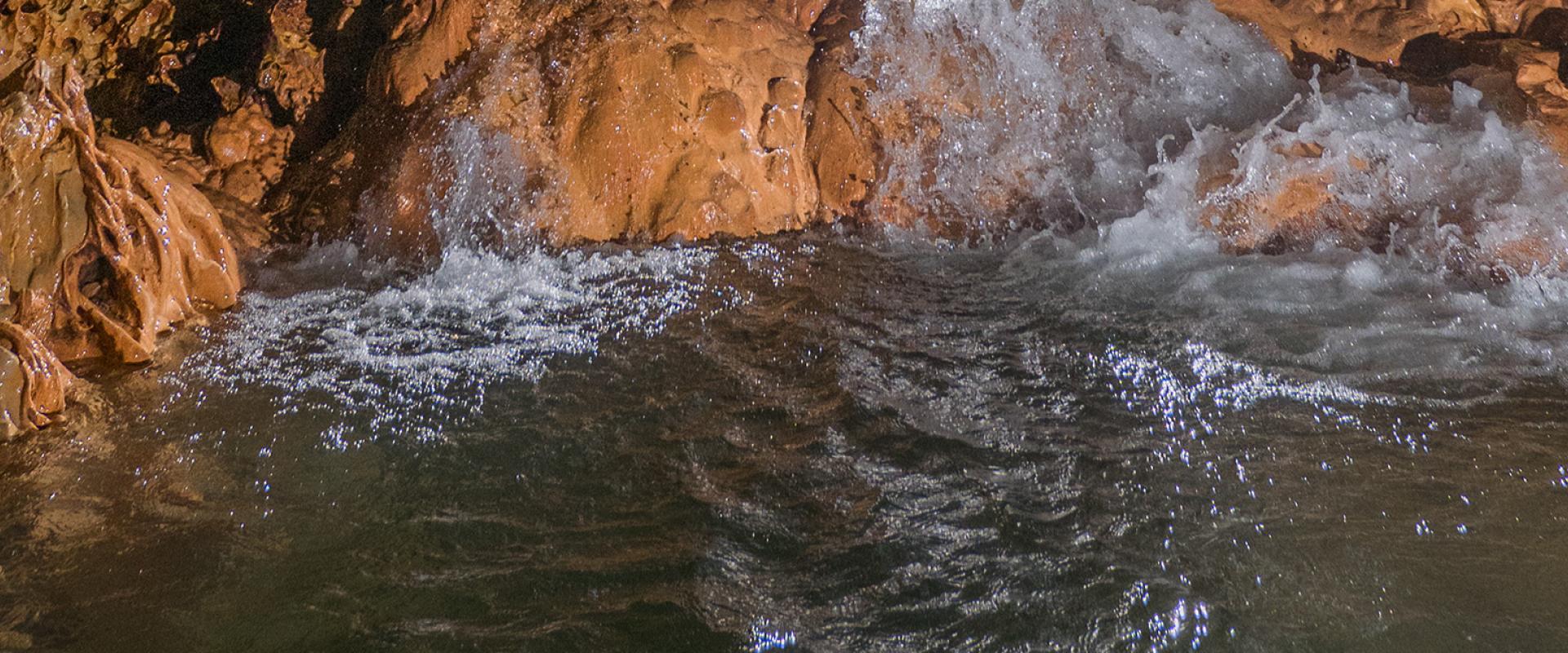
Map of water table levels in France on 1 June 2022.
© BRGM
Hydrogeological situation on 1 June 2022
Following a particularly poor recharge, the depletion period began in January-February, two to three months earlier than normal. In May, the depletion continued and all the water table levels were decreasing.
Insufficient rainfall during the winter had a significant impact on the state of the water tables and the situation deteriorated rapidly from February 2022. Groundwater levels were generally below or at their average levels for May. The situation is particularly worrying, with low to very low levels in the aquifers between Périgord, Vendée, Maine and Touraine and in the aquifers of the Côte d'Azur, Provence and Bas-Dauphiné.
In June, the levels of inertial aquifers are expected to continue their downward trend. The situation of these aquifers is not expected to change much in the next few weeks, except in areas where there is a strong demand for water. As regards reactive water tables, the trends and developments will depend primarily on effective local rainfall, the degree of evapotranspiration and the demand on water supplies. The periods of rainfall expected in June could have a beneficial effect on the most reactive water tables at a local level. In the event of insufficient rainfall, the state of the reactive aquifers would further deteriorate. The situation needs to be closely monitored in all the reactive aquifers as well as in inertial aquifers which currently have low water levels, and in areas where withdrawals are particularly intensive.

Map of water table levels in France on 1 June 2022.
© BRGM
Groundwater trends
The aquifers across the entire country experienced a winter recharge that was well below average in 2021-2022. This recharge period ended two to three months early, between January and March, due to the lack of significant rainfall. Consequently, the aquifers began to empty and the groundwater levels began to fall.
In the month of May, almost all the water-table levels were down. This is due to the absence of significant rainfall, the regrowth of vegetation and the increase in evapotranspiration. Consequently, the rainfall filtering down through the soil was almost entirely taken up by the vegetation and thus contributed very little to recharging the aquifers.
Only the water tables in the south-east of France had increases in levels. Rainfall and snowmelt led to small increases in the alluvial aquifers in the Alps and in karstic limestone aquifers. The alluvial aquifers of the middle and lower regions of the Durance river were recharged by the infiltration of surplus water from gravity-fed irrigation.
Situation in relation to May averages
The extremely low recharge in the autumn and winter of 2021-2022 has had a major impact on groundwater levels. Consequently, the state of the water tables deteriorated from February onwards, except in a few areas that benefited from sufficient effective rainfall during the spring. In May, the consequences of insufficient rainfall, combined with high temperatures, was reflected in the groundwater levels. The situation is deteriorating rapidly, particularly in the most reactive aquifers and in areas subject to intensive groundwater withdrawals. Levels are below or well below monthly norms.
The situation in the inertial aquifers in Northern France has been slowly deteriorating since February. In May, the situation deteriorated more rapidly towards the south than in the north. For instance, levels remained in line with monthly averages in the north and centre of the Paris Basin. To the south and east, the levels were less satisfactory, from moderately low to low in the chalk and tufa rock aquifers of Touraine.
The situation in the inertial aquifers of the Rhône-Saône corridor is gradually getting worse. The drop in aquifer levels may be exacerbated by groundwater abstraction. The following areas also have unsatisfactory levels: from moderately low in the fluvio-glacial aquifers of the middle and upper Rhône corridors to low in the Plio-Quaternary gravel aquifers stretching from the Dijon region to the Dombes and in the Miocene molasse aquifer in Bas-Dauphiné.
Reactive aquifers are particularly suffering from the lack of rainfall and their situation is deteriorating rapidly. Levels are generally below monthly norms. Very low levels have been recorded in several areas that have not received much rain for several months: Périgord, Vendée and Maine, as well as Côte d'Azur, Provence and Bas-Dauphiné.
The situation is positive in several aquifers, with moderately high to approximately normal levels compared to those recorded in May in previous years:
- The levels in the chalk aquifers of the Artois-Picardy and Normandy-Picardy regions and the aquifers in the tertiary formations of the central Paris Basin, which are not very sensitive to a lack of effective rainfall, remain close to normal levels;
- The alluvial aquifers of Garonne and Dordogne rivers and their main tributaries benefited from several recharge periods in March and April. Their levels range from approximately normal to moderately high;
- The alluvial and Pliocene aquifers of the Languedoc coast and Roussillon benefited from effective rainfall in March and April and their levels are comparable to normal.
A less positive situation was recorded in certain aquifers, whose levels were moderately low (or even low to very low, in some areas) compared to May averages:
- The Jurassic limestone aquifers in the south of the Vendée region have low to very low water levels, due to a lack of effective rainfall over several months;
- The levels in chalk aquifers of the Touraine region are low, since the recharge period started late and did not last long;
- Water levels are low in the inertial Plio-Quaternary gravel aquifer of Burgundy-Franche-Comté. This is the consequence of several, successive poor recharge periods;
- Water levels are low in the alluvial aquifers and in the complex formations of Provence and the Côte d'Azur, due to insufficient recharges in 2020-2021 and 2021-2022, as well as a fairly severe low-water period in the summer of 2021;
- The levels in the Miocene molasse aquifer in the Bas-Dauphiné region are generally low. This is also linked to the gradual decrease in levels over several years. Very low levels were recorded in the Valence plain and in the northern hills of the Drôme in May.
Forecasts
The seasonal forecasts of Météo-France predict “drier than normal conditions” across two thirds of the south of France over the next 3 months. No dominant scenario has been forecast for the north of France. Temperatures are expected to be higher than normal across the whole country. High temperatures, the regrowth of vegetation and thus increased evapotranspiration usually limit the infiltration of rainfall into aquifers during spring and summer. Theoretically, the depletion should therefore continue and the levels should remain on a downward trend for the next few weeks. In addition, insufficient rainfall and high temperatures result in dry soils and hence a greater demand for water.
As it stands, unless there are truly exceptional rainfall events, no recharge episodes are expected in the inertial aquifers, so, no improvement is likely before the autumn. The situation is expected to gradually deteriorate, more or less rapidly depending on the volumes of groundwater withdrawn.
As regards reactive water tables, the trends and developments will depend primarily on effective local rainfall and the demand on water supplies. If there is insufficient rainfall, levels will remain low and the situation will continue to deteriorate rapidly. However, significant rainfall events could result in brief recharges, which would help maintain groundwater levels and possibly even lead to increases, here and there. In this case, the situation might improve in certain areas, although above normal levels would still not be reached in the aquifers that have extremely low levels.
The situation will need to be closely monitored in all the reactive aquifers, and in particular in the aquifers whose levels were below monthly norms in May. The inertial chalk aquifers in the Touraine region, the Plio-Quaternary gravel aquifers in Bourgogne-Franche-Comté and Miocene molasse aquifer in Bas-Dauphiné also need to be closely monitored.
Hydrological Status Report
The national hydrological status report consists of a set of maps with corresponding comments that show the monthly evolution of water resources. It describes the quantitative situation of aquatic environments (effective rainfall, river discharge, groundwater table levels, reservoir-dam filling status) and provides summary information on Prefectoral Orders issued to limit water use during the low-water period.
Press contact








